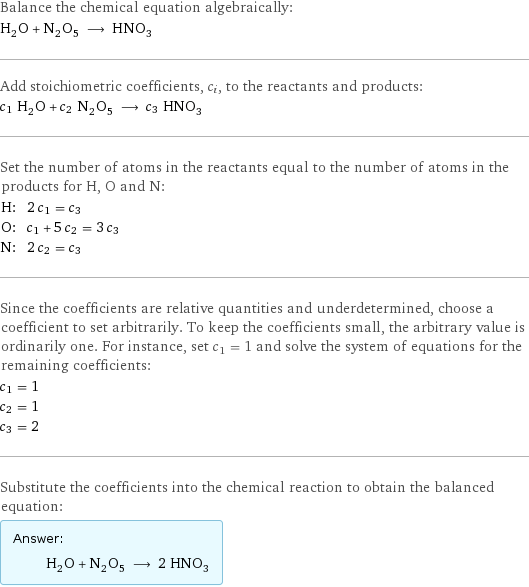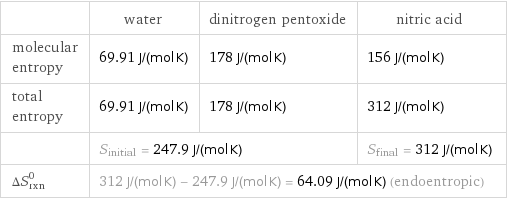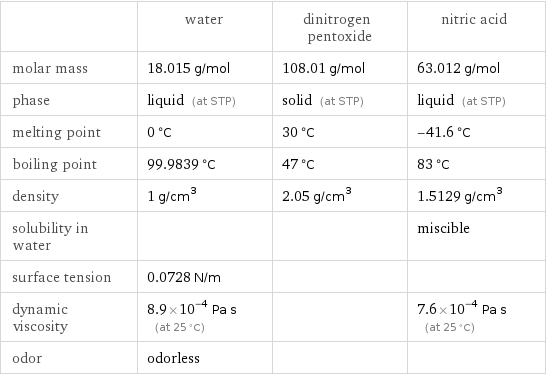Input interpretation

H_2O water + N_2O_5 dinitrogen pentoxide ⟶ HNO_3 nitric acid
Balanced equation

Balance the chemical equation algebraically: H_2O + N_2O_5 ⟶ HNO_3 Add stoichiometric coefficients, c_i, to the reactants and products: c_1 H_2O + c_2 N_2O_5 ⟶ c_3 HNO_3 Set the number of atoms in the reactants equal to the number of atoms in the products for H, O and N: H: | 2 c_1 = c_3 O: | c_1 + 5 c_2 = 3 c_3 N: | 2 c_2 = c_3 Since the coefficients are relative quantities and underdetermined, choose a coefficient to set arbitrarily. To keep the coefficients small, the arbitrary value is ordinarily one. For instance, set c_1 = 1 and solve the system of equations for the remaining coefficients: c_1 = 1 c_2 = 1 c_3 = 2 Substitute the coefficients into the chemical reaction to obtain the balanced equation: Answer: | | H_2O + N_2O_5 ⟶ 2 HNO_3
Structures

+ ⟶
Names

water + dinitrogen pentoxide ⟶ nitric acid
Reaction thermodynamics
Gibbs free energy

| water | dinitrogen pentoxide | nitric acid molecular free energy | -237.1 kJ/mol | 113.9 kJ/mol | -80.7 kJ/mol total free energy | -237.1 kJ/mol | 113.9 kJ/mol | -161.4 kJ/mol | G_initial = -123.2 kJ/mol | | G_final = -161.4 kJ/mol ΔG_rxn^0 | -161.4 kJ/mol - -123.2 kJ/mol = -38.2 kJ/mol (exergonic) | |
Entropy

| water | dinitrogen pentoxide | nitric acid molecular entropy | 69.91 J/(mol K) | 178 J/(mol K) | 156 J/(mol K) total entropy | 69.91 J/(mol K) | 178 J/(mol K) | 312 J/(mol K) | S_initial = 247.9 J/(mol K) | | S_final = 312 J/(mol K) ΔS_rxn^0 | 312 J/(mol K) - 247.9 J/(mol K) = 64.09 J/(mol K) (endoentropic) | |
Equilibrium constant
![Construct the equilibrium constant, K, expression for: H_2O + N_2O_5 ⟶ HNO_3 Plan: • Balance the chemical equation. • Determine the stoichiometric numbers. • Assemble the activity expression for each chemical species. • Use the activity expressions to build the equilibrium constant expression. Write the balanced chemical equation: H_2O + N_2O_5 ⟶ 2 HNO_3 Assign stoichiometric numbers, ν_i, using the stoichiometric coefficients, c_i, from the balanced chemical equation in the following manner: ν_i = -c_i for reactants and ν_i = c_i for products: chemical species | c_i | ν_i H_2O | 1 | -1 N_2O_5 | 1 | -1 HNO_3 | 2 | 2 Assemble the activity expressions accounting for the state of matter and ν_i: chemical species | c_i | ν_i | activity expression H_2O | 1 | -1 | ([H2O])^(-1) N_2O_5 | 1 | -1 | ([N2O5])^(-1) HNO_3 | 2 | 2 | ([HNO3])^2 The equilibrium constant symbol in the concentration basis is: K_c Mulitply the activity expressions to arrive at the K_c expression: Answer: | | K_c = ([H2O])^(-1) ([N2O5])^(-1) ([HNO3])^2 = ([HNO3])^2/([H2O] [N2O5])](../image_source/6a5b0fac7498f72a8b82a4dbf34020ae.png)
Construct the equilibrium constant, K, expression for: H_2O + N_2O_5 ⟶ HNO_3 Plan: • Balance the chemical equation. • Determine the stoichiometric numbers. • Assemble the activity expression for each chemical species. • Use the activity expressions to build the equilibrium constant expression. Write the balanced chemical equation: H_2O + N_2O_5 ⟶ 2 HNO_3 Assign stoichiometric numbers, ν_i, using the stoichiometric coefficients, c_i, from the balanced chemical equation in the following manner: ν_i = -c_i for reactants and ν_i = c_i for products: chemical species | c_i | ν_i H_2O | 1 | -1 N_2O_5 | 1 | -1 HNO_3 | 2 | 2 Assemble the activity expressions accounting for the state of matter and ν_i: chemical species | c_i | ν_i | activity expression H_2O | 1 | -1 | ([H2O])^(-1) N_2O_5 | 1 | -1 | ([N2O5])^(-1) HNO_3 | 2 | 2 | ([HNO3])^2 The equilibrium constant symbol in the concentration basis is: K_c Mulitply the activity expressions to arrive at the K_c expression: Answer: | | K_c = ([H2O])^(-1) ([N2O5])^(-1) ([HNO3])^2 = ([HNO3])^2/([H2O] [N2O5])
Rate of reaction
![Construct the rate of reaction expression for: H_2O + N_2O_5 ⟶ HNO_3 Plan: • Balance the chemical equation. • Determine the stoichiometric numbers. • Assemble the rate term for each chemical species. • Write the rate of reaction expression. Write the balanced chemical equation: H_2O + N_2O_5 ⟶ 2 HNO_3 Assign stoichiometric numbers, ν_i, using the stoichiometric coefficients, c_i, from the balanced chemical equation in the following manner: ν_i = -c_i for reactants and ν_i = c_i for products: chemical species | c_i | ν_i H_2O | 1 | -1 N_2O_5 | 1 | -1 HNO_3 | 2 | 2 The rate term for each chemical species, B_i, is 1/ν_i(Δ[B_i])/(Δt) where [B_i] is the amount concentration and t is time: chemical species | c_i | ν_i | rate term H_2O | 1 | -1 | -(Δ[H2O])/(Δt) N_2O_5 | 1 | -1 | -(Δ[N2O5])/(Δt) HNO_3 | 2 | 2 | 1/2 (Δ[HNO3])/(Δt) (for infinitesimal rate of change, replace Δ with d) Set the rate terms equal to each other to arrive at the rate expression: Answer: | | rate = -(Δ[H2O])/(Δt) = -(Δ[N2O5])/(Δt) = 1/2 (Δ[HNO3])/(Δt) (assuming constant volume and no accumulation of intermediates or side products)](../image_source/8cbd3184bbb573096fcbefe72b5344c7.png)
Construct the rate of reaction expression for: H_2O + N_2O_5 ⟶ HNO_3 Plan: • Balance the chemical equation. • Determine the stoichiometric numbers. • Assemble the rate term for each chemical species. • Write the rate of reaction expression. Write the balanced chemical equation: H_2O + N_2O_5 ⟶ 2 HNO_3 Assign stoichiometric numbers, ν_i, using the stoichiometric coefficients, c_i, from the balanced chemical equation in the following manner: ν_i = -c_i for reactants and ν_i = c_i for products: chemical species | c_i | ν_i H_2O | 1 | -1 N_2O_5 | 1 | -1 HNO_3 | 2 | 2 The rate term for each chemical species, B_i, is 1/ν_i(Δ[B_i])/(Δt) where [B_i] is the amount concentration and t is time: chemical species | c_i | ν_i | rate term H_2O | 1 | -1 | -(Δ[H2O])/(Δt) N_2O_5 | 1 | -1 | -(Δ[N2O5])/(Δt) HNO_3 | 2 | 2 | 1/2 (Δ[HNO3])/(Δt) (for infinitesimal rate of change, replace Δ with d) Set the rate terms equal to each other to arrive at the rate expression: Answer: | | rate = -(Δ[H2O])/(Δt) = -(Δ[N2O5])/(Δt) = 1/2 (Δ[HNO3])/(Δt) (assuming constant volume and no accumulation of intermediates or side products)
Chemical names and formulas

| water | dinitrogen pentoxide | nitric acid formula | H_2O | N_2O_5 | HNO_3 name | water | dinitrogen pentoxide | nitric acid IUPAC name | water | nitro nitrate | nitric acid
Substance properties

| water | dinitrogen pentoxide | nitric acid molar mass | 18.015 g/mol | 108.01 g/mol | 63.012 g/mol phase | liquid (at STP) | solid (at STP) | liquid (at STP) melting point | 0 °C | 30 °C | -41.6 °C boiling point | 99.9839 °C | 47 °C | 83 °C density | 1 g/cm^3 | 2.05 g/cm^3 | 1.5129 g/cm^3 solubility in water | | | miscible surface tension | 0.0728 N/m | | dynamic viscosity | 8.9×10^-4 Pa s (at 25 °C) | | 7.6×10^-4 Pa s (at 25 °C) odor | odorless | |
Units
